Since the advent of Bitcoin in 2009, numerous different cryptocurrencies have been proposed and implemented. Some have aimed to be modest improvements on Bitcoin’s promise of digital cash, while others have aimed to do radically different things than Bitcoin using the same basic blockchain technology. Many have fallen by the wayside only shortly after their release.
In this crowd of cryptocurrencies following Bitcoin, however, two other early blockchains continued to grow and distinguish themselves as some of the largest blockchains by market capitalization:
- Litecoin, created in 2011, is currently the #5 cryptocurrency by market cap at ~$3.4 billion USD.
- Ethereum, created in 2014, is currently the #2 cryptocurrency by market cap at ~$24.1 billion USD.
Litecoin and Ethereum have a lot of similarities. For example, they were both started by publicly known figures — Charles Lee and Vitalik Buterin, respectively — who have become their de facto leaders, despite the blockchains’ decentralized nature. They’ve also both proven their ability to cultivate a community and survive for longer than a few months, which sets them apart from many other crypto projects.
Yet Litecoin and Ethereum are drastically different from each other, too. Most centrally, even though they’re both blockchains, they aim to do completely different things: Litecoin wants to function as a low-fee, near-instant payment system for everyday transactions, whereas Ethereum wants to be a kind of decentralized, global supercomputer on which people can run all manner of decentralized software applications (or “DApps”).
Here’s how Litecoin vs Ethereum compared by the numbers back when Ethereum was publicly released on August 7, 2015:
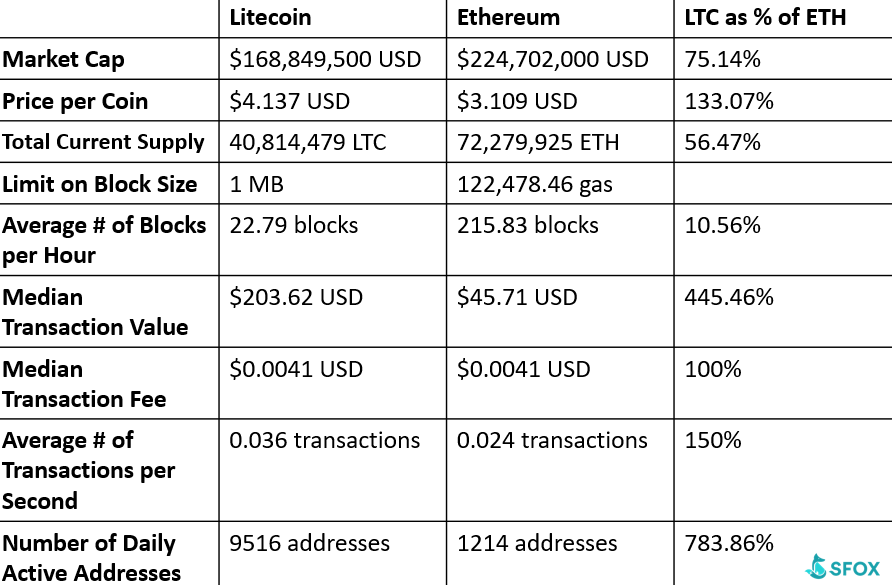
And here’s how they stack up to each other as of September 25, 2018:
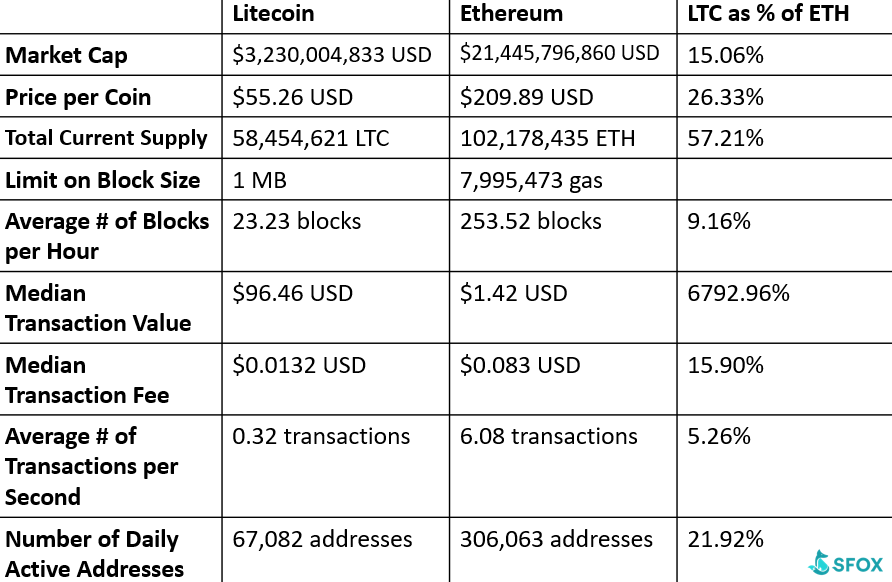
In evaluating the relative success of Litecoin vs Ethereum, we face the same problem we encountered when we compared Bitcoin Cash vs Ethereum: because the former is aiming to be digital cash whereas the latter is aiming to be a worldwide computer, it’s hard to even determine appropriate metrics by which to compare the two.
We’re going to analyze LTC and ETH’s progress by comparing them across three dimensions:
- Functionality: What need is each blockchain trying to fill, and what is its path to filling it?
- User base: How many people are actually using each network on a regular basis, and how is each community evolving over time?
- Transaction efficiency: How is each network managing user transactions in terms of costliness and timeliness?
The story that seems to emerge from the data is this: While Litecoin had a headstart on Ethereum, it’s been set back by several big-name competitors, while Ethereum has moved ahead by finding several compelling cases of product-market fit.
Functionality: Digital money versus an all-purpose computer
The growth trajectory of Litecoin vs Ethereum is one of depth vs breadth: Litecoin is trying to serve a single function extremely well, whereas Ethereum is trying to enable an entire ecosystem of new applications, each of which solves a different problem.

Lee designed Litecoin to do a single thing better than Bitcoin: allow people to efficiently make everyday transactions. The code for Litecoin’s network is almost identical to Bitcoin’s, with a few minor tweaks designed to better serve this purpose. Here’s a chart to see how Bitcoin and Litecoin are alike and different at a glance:
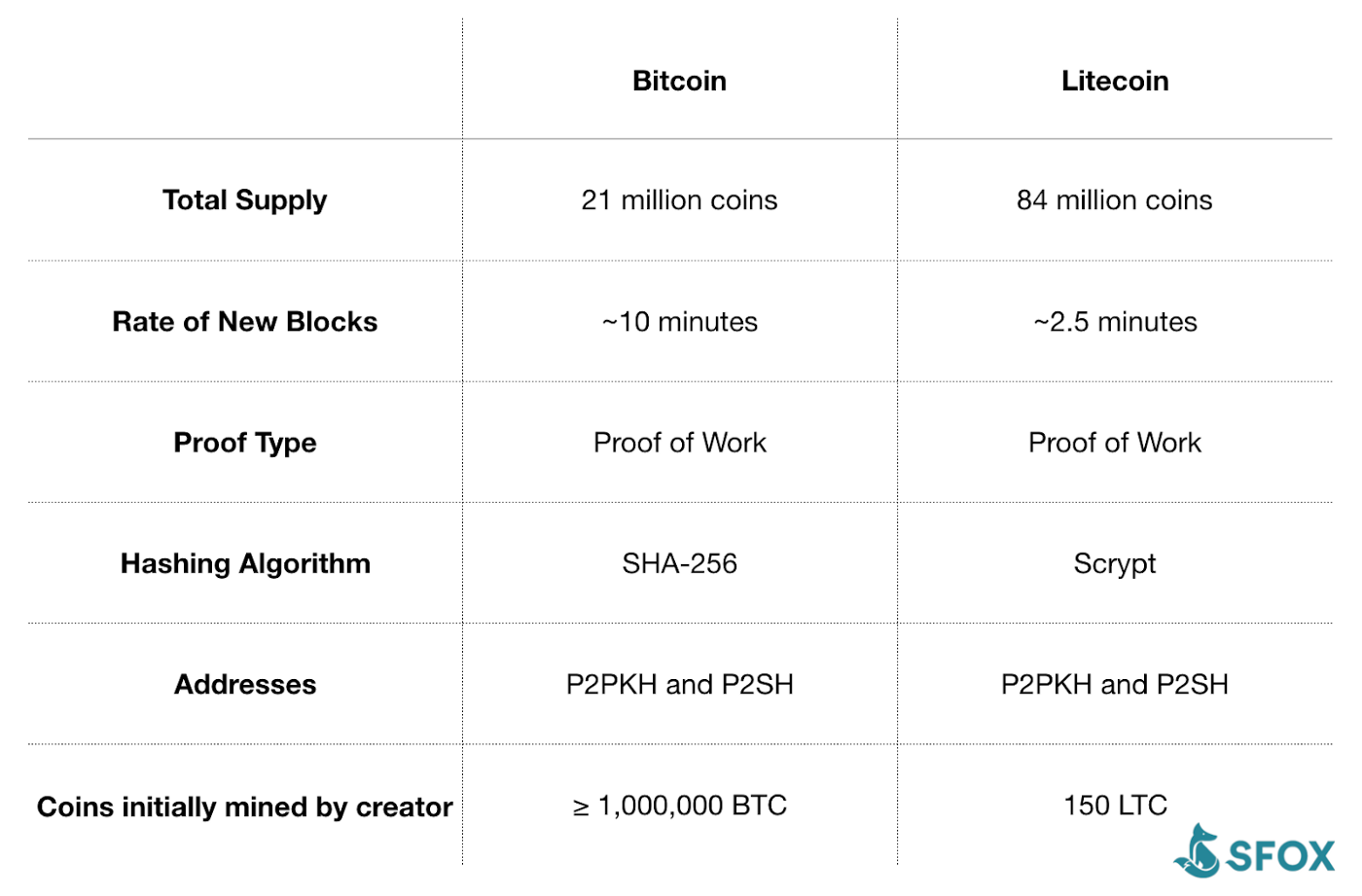
The most critical datum from the above chart when it comes to daily commerce is the rate of new blocks: because new Litecoin blocks are generated roughly four times as fast as Bitcoin blocks are, user transactions can be confirmed faster, which is critical for everyday commerce. (Notice, though, that 2.5 minutes for a new block is still far slower than handing someone cash or swiping a credit card.)
While Litecoin has focused on making digital commerce as efficient as possible, Ethereum has focused on empowering developers to make any any kind of decentralized application imaginable. That’s led it to focus on being flexible enough to support a diverse ecosystem, whereas Litecoin — like Bitcoin — has maintained a much more primitive programming language in order to stay more secure as a payment channel. Flexibility has given rise to more high-profile security issues in Ethereum than you hear about in Litecoin — but it’s also made Ethereum capacious enough to naturally discover at least one compelling product-market fit over the last few years.
That one compelling product market fit is the ICO, or “initial coin offering”: a strategy for blockchain-based startups to crowdfund themselves by creating and issuing tokens than run on Ethereum. Since ICOs came to prominence in mid-2017, they’ve steadily grown as strategy for raising capital — even as the regulatory landscape surrounding them remains somewhat murky.
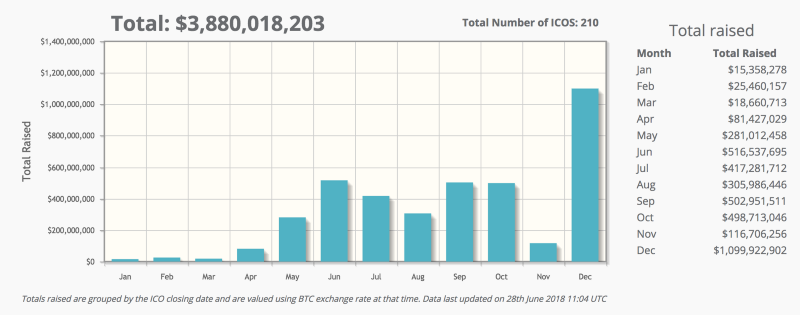
This trend has only continued through 2018: to date, over $20 billion USD has been raised in 2018 through ICOs, according to CoinSchedule. That’s not to say that the ICO will be the only product-market fit to be found on top of Ethereum, but the ICO does serve as a compelling example of how valuable Ethereum can be when something built on top of it proves useful.
User base: Litecoin and Ethereum face different competitive landscapes
Currencies and computer networks have one key thing in common when it comes to determining their value: in order for them to be valuable, people need to actually use them. So, how do the communities of Litecoin and Ethereum compare? Are they growing, stagnant, or dwindling?
Litecoin seems to be at a disadvantage here because it has more entrenched, high-profile competitors than Ethereum does. Remember, Litecoin’s goal is to be digital cash — that’s its only intended function. Therefore, it’s competing against a wide range of alternative payment methods, including:
- Bitcoin
- Bitcoin Cash
- VISA
- Venmo
- Ordinary cash
That makes its path to adoption an uphill battle, which is reflected in the fact that, to date, the Litecoin foundation has only listed about 200 merchants that accept LTC — and many merchants that accept LTC have elected to more broadly accept cryptocurrency-based payment through a method like BitPay, rather than specifically electing to accept LTC over an alternative like BTC or BCH.
This certainly isn’t to say that there’s no way for Litecoin to succeed in the long-term. The takeaway here is that the onus is on the Litecoin community to clearly articulate and reinforce the unique value proposition of Litecoin. Why is Litecoin better than every one of the five alternatives listed above for daily commercial transactions? In this regard, it’s a little worrying that Litecoin is known for having a relatively quiet base. To take one metric as an example, there are about 2,700 tweets per day about Litecoin right now, whereas there are about 10,800 tweets per day about Ethereum.

In contrast, Ethereum is a network enabling something totally new: decentralized applications. That makes its value proposition less obvious than Litecoin’s, but it also means that it has relatively less competition. As a result, the growing community of developers interested in building centralized applications have rallied around Ethereum and lifted it to prominence as a leading blockchain.
One way to see this growth is through the size of Ethereum’s Devcon, which has rapidly grown since its first iteration:
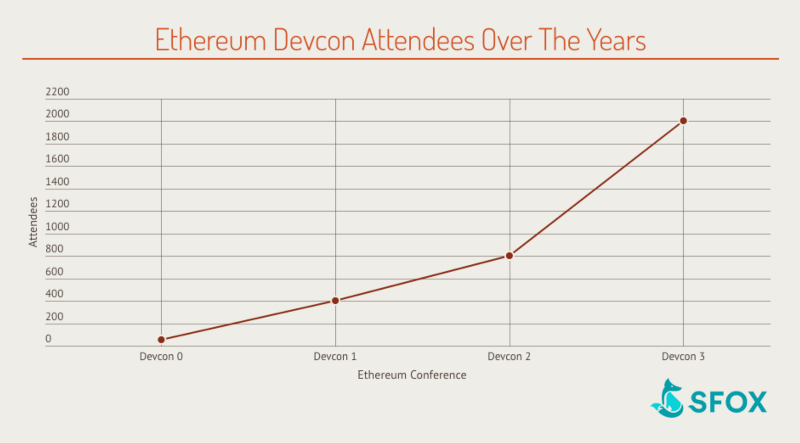
Some of the projects being built on top of Ethereum also have the potential to add a multiplier to the impact of its overall community. 0x Protocol, for instance, aims to provide a protocol for building exchanges where people can trade other tokens that have been built on top of Ethereum. As more projects create tokens that represent everything from goods to services, to physical objects, this kind of inter-token liquidity will become increasingly valuable — and that value could translate to increased value for the underlying Ethereum network.
Transaction efficiency: Two different sides to the problem of scale
If they want to build and sustain a robust community of users, computers and currencies both need to have transactional efficiency: users need to be able to interact with online applications and spend currency in a timely manner with low fees, regardless of how many other people are using the network.
At first glance, it might seem that Litecoin is beating out Ethereum in terms of transaction efficiency: even though the median Litecoin transaction is almost 6800% of the median Ethereum transaction ($96.46 USD vs $1.42 USD), the median Litecoin transaction fee is about 16% of the median Ethereum transaction fee ($0.0132 USD vs $0.083 USD).
Look closer, though, and you might notice something else: Ethereum is processing almost 20 times as many transactions per second as Litecoin is. So the lower fees currently associated with Litecoin may be less of a signal of its overall efficiency and more of a symptom of its relatively low transaction volume.

This points to a more central question that’s currently on many people’s minds when it comes to blockchain transaction efficiency: assuming that widespread adoption is successful, how will this technology remain fast and low-fee as more people begin to regularly use it? In other words, how will blockchains like Litecoin and Ethereum effectively scale as they become more congested?
When it comes to Litecoin, some people — including its creator, Charles Lee — see scaling as a solution rather than a problem. Last year, he wrote an article detailing how he believed that Lightning Network (the primary, off-chain scaling solution currently proposed for Bitcoin and Litecoin) could potentially clarify Litecoin’s value proposition in the overall crypto ecosystem:
“Even with LN [Lightning Network], Bitcoin still cannot service every person in the world. I think the calculation was that at 1MB blocks, LN and SegWit on Bitcoin can service 500M users. LN nodes will charge a fee for LN txns going through them and that fee will be relative to the Bitcoin network fee. So Bitcoin LN txns will be more expensive than Litecoin LN txns. It may make economic sense for a LN txn to go via Litecoin and back to Bitcoin to get the cheapest rate. Lightning makes this possible because it allows the two LN to be interoperable.”
In other words, as Lightning Network becomes more established as a method of scaling Bitcoin, the proportionate fees for transacting with Litecoin vs Bitcoin could end up incentivizing people to use Litecoin as a kind of intermediary coin for getting better rates on Bitcoin transactions. Whether this will actually be the case remains to be seen, as Lightning Network itself was only launched earlier this year and is still in its early days — but, if it ends up being true, it could help to answer our earlier question of what distinctive value Litecoin provides that it competitors don’t.
Ethereum, meanwhile, is well aware of its congestion issue. That’s why there are multiple high-profile projects intended to ease network congestion to keep transaction speeds high and fees low. Here’s a roundup of some of the key players in this space:
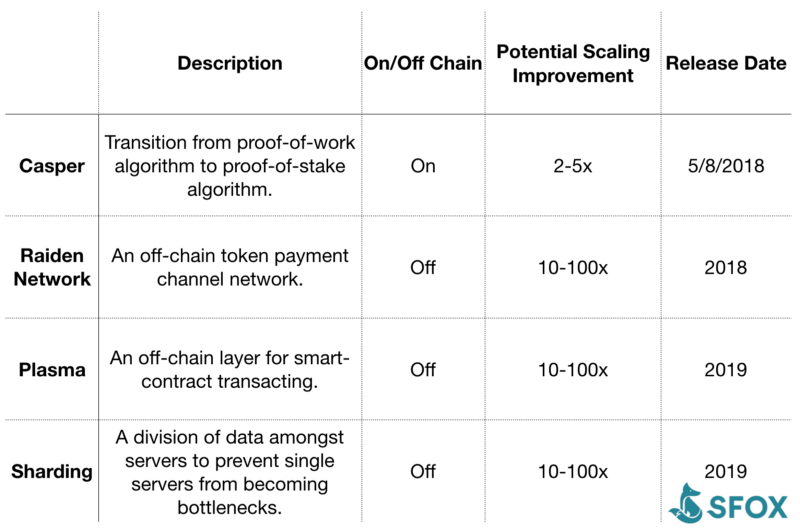
Scaling issues are clearly far more pressing for Ethereum than they are for Litecoin, but the comparison is almost unfair since Ethereum has the most daily transactions of any major cryptocurrency right now. And remember, given Ethereum’s function as a common basis for many decentralized applications, this outcome was almost inevitable.
It’s likely that Ethereum’s fees will ease soon given the many developers working on scaling solutions. What’s especially interesting to note here in our comparison of Litecoin vs Ethereum, though, is that Litecoin is almost positioning itself as a “scaling solution” for Bitcoin, analogous to something like Raiden Network for Ethereum: one of the potential ways for Litecoin to secure its own long-term value could be as an intermediary that eases Bitcoin congestion.
Sales is king
The old adage that “sales is king” has some truth to it when it comes to cryptocurrencies like Litecoin and Ethereum. Especially now that so many other crypto projects have emerged, successful cryptocurrencies need to (1) articulate a clear value proposition that they can sell themselves on and (2) cultivate a community that’s committed to evangelizing that value proposition.
Despite being younger, Ethereum seems to be ahead of Litecoin in this regard: the network has a clear function that’s inspired a community of developers to push further grow, adoption, and scalability. Though Litecoin remains one of the most successful cryptocurrencies to date, it needs clearer market positioning and a more vibrant community if it wants to maintain that position.
The above references an opinion and is for informational purposes only. It is not intended as and does not constitute investment advice, and is not an offer to buy or sell or a solicitation of an offer to buy or sell any cryptocurrency, security, product, service or investment. Seek a duly licensed professional for investment advice. The information provided here or in any communication containing a link to this site is not intended for distribution to, or use by, any person or entity in any jurisdiction or country where such distribution or use would be contrary to law or regulation or which would subject SFOX, Inc. or its affiliates to any registration requirement within such jurisdiction or country. Neither the information, nor any opinion contained in this site constitutes a solicitation or offer by SFOX, Inc. or its affiliates to buy or sell any cryptocurrencies, securities, futures, options or other financial instruments or provide any investment advice or service.



